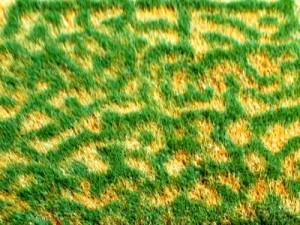Category: Solving problems
The first step in solving problems in lawns, sports fields, and golf courses is to describe the problem and put it into context. Many turf problems are noticed as a change, e.g., brown grass that was previously green. Others problems are a failure to meet expectations, e.g., a turf manager plants grass seed which does not grow. Both kinds of problems require a description of the problem and the context, either before vs. after or expectation vs. reality. Time and space are critical in describing a problem, for example, knowing when the grass was green or when the seed was planted.
 More complex turfgrass problems involve different entities. For example, your Homeowner’s Association contracted with an irrigation company to manage your irrigation system. After a few months the grass was dry. In this case the description should mention the dry grass, the history of when the grass was not dry, the ensuing weather, and importantly, what exactly was the responsibility of the irrigation company? Does anyone else share responsibility? What exactly does the contract say?
More complex turfgrass problems involve different entities. For example, your Homeowner’s Association contracted with an irrigation company to manage your irrigation system. After a few months the grass was dry. In this case the description should mention the dry grass, the history of when the grass was not dry, the ensuing weather, and importantly, what exactly was the responsibility of the irrigation company? Does anyone else share responsibility? What exactly does the contract say?
Solving problems in turfgrass is fascinating but takes rigor to describe as completely and as independently as possible the facts of the problem and the context in time, place, and responsibility. Solving problems also requires preparation in knowing the relationships of grasses, management, and environmental factors, and keeping an open-minded view of what is or is not “normal.”
I need know which weed control product(s) to use on my ornamental perennial peanut, subterranean stems – rhizomes type, in a large area of the backyard (on a one-acre lot). Weeds are a mix...
The South Florida Turf Expo will be March 23, 2017, 7:30 am to 3:00 pm, at the University of Florida / IFAS at 3205 College Ave., Davie, FL 33314 and is sponsored by the...
pro_builder – posted 06 March 2012 16:18 I recently filled in an old, cracked pool. Do I need to break up and remove the “cool deck” around the pool or can I simply cover...
ihateryegras – posted 16 July 2015 15:04 Please help Scotts employee at home depot suggested I mix perennial ryegrass with Bluegrass, now Bluegrass wont grow and ryegrass is growing 3 times faster and stealing...
sandini – posted 19 August 2015 13:33 What is a chemical I can use to stop St Augustine trailers from growing under the soil and entering my gardens?HELP!!!
rickkil23 – posted 04 July 2014 04:17 good morning, I was hoping someone here could help me with this issue. as stated in subject, I am having issues with my st Augustine lawn, it...
LawnLover871 – posted 31 March 2015 15:30 Hi everyone. I just planted tall fescue two weeks ago and it was coming up well until I noticed some of the blades looked bleached. The sprouts...
hfowle1 – posted 21 August 2012 09:35 I had new sod planted about 4-5 weeks ago in a long strip along the sidewalk at my house. It had been looking good until roughly 10...
saf88 – posted 13 May 2013 12:05 We just installed new sod 4 days ago and it is already turning brown. Sod preps included tilling, fertilizing, and leveling. We have been watering for one...
dcoton007 – posted 14 May 2013 12:25 I am seeking the forums advice on a particular issue that I find myself dealing with at a new to me home. This home has a fairly...

 More complex turfgrass problems involve different entities. For example, your Homeowner’s Association contracted with an irrigation company to manage your irrigation system. After a few months the grass was dry. In this case the description should mention the dry grass, the history of when the grass was not dry, the ensuing weather, and importantly, what exactly was the responsibility of the irrigation company? Does anyone else share responsibility? What exactly does the contract say?
More complex turfgrass problems involve different entities. For example, your Homeowner’s Association contracted with an irrigation company to manage your irrigation system. After a few months the grass was dry. In this case the description should mention the dry grass, the history of when the grass was not dry, the ensuing weather, and importantly, what exactly was the responsibility of the irrigation company? Does anyone else share responsibility? What exactly does the contract say?
I almost forgot Do Not over water. Floratan /Seville all strains of St. Augustine are suseptible to fungus from over…
I am from the north and it has taken me five yrs to learn and undertand seville lawns. No 1…
To insert an image into a new post, either first upload it using the "+ New" button in the upper…
To insert an image < 2 MB in size in a comment, below "Leave a Reply" click BROWSE.
How do you post pictures...found link to images, but still unable to post pics.